 |
Zitadelle Vechta
Vechta, Germany
|
|
 |
Constructed: 1666-1669
Used by: Münster Bishopric
Conflict in which it participated:
Seven Years' War
Razed: 1769
|
Created from the ashes of one perfectly ridiculous European war and undone by another, the heroic Zitadelle Vechta is a prime example of the push and pull betwixt defensive and offensive military technology. And possibly really great hats.
Germany, or technically the Holy Roman Empire, was an unholy mess at the end of the Thirty Years' War (1618-1648). Initiated thanks to Holy Roman Emperor Ferdinand II (1578-1637)'s determination to suppress Protestantism throughout his empire, this conflict eventually drew the rest of Europe into the fray, killed off around 30% of Germany's population, and left the Holy Roman Empire split into nearly 2,000 individual squirming little fifedoms. |
 |
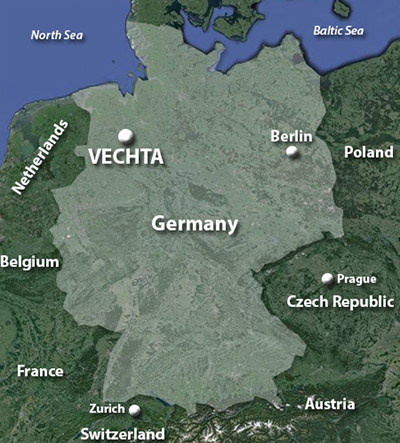 |
|
Vechta, the city of our current interest, suffered particularly in the Thirty Years' War. Owned and operated by the Bishopric of Münster since the Middle Ages, Vechta found itself occupied by the Swedish army at the end of the war. The Swedes finally left in 1654, and the returning Bishop of Münster (in the person of Christoph Bernhard von Galen (1606-1678)) determined that his lovely Vechta would never again be defenseless against a foreign enemy.
|
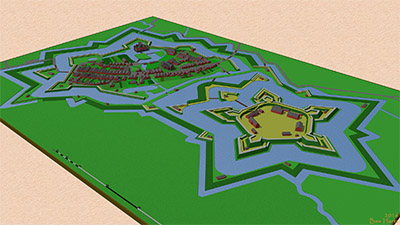 The town and Zitadelle of Vechta, before the fire of 1684... The town and Zitadelle of Vechta, before the fire of 1684...
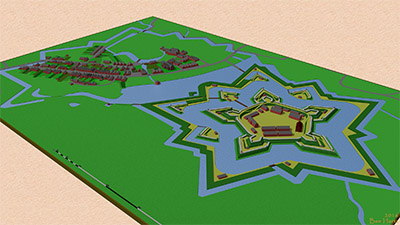 ...and after the fire, around 1705. Note how much more Zitadelle, and less town there is! Many thanks to Mr. Ben Hartz for the illustrations! Click on them, they're large and luscious! ...and after the fire, around 1705. Note how much more Zitadelle, and less town there is! Many thanks to Mr. Ben Hartz for the illustrations! Click on them, they're large and luscious!
|
 |
Bishop von Galen compelled there to be created the most modern defensive work possible which, in the halcyon days of 1666, was a starfort built in the style of Vauban. Initially named Santa Maria, so that everyone would be confused and think the Spanish were building a starfort in Germany, each bastion was named for one of the illustrious Catholic potentates who were responsible for its construction: von Galen; Ferdinand; Maximilian; Friedrich Christian and, since the fort had five bastions but I've only been able to find the names of four of them, I'll just name the last bastion after Luke of the Goats, a Florentine military engineer who may or may not have had a major role in the construction of the Italian Fortezza di Sarzana, one of the very first starforts, 150 years previously. Dude ought to have something named after him. The Zitadelle was built just to the west of Vechta, and the city's existing walls were joined with those of the fort (a phenomenon known entertainingly as Irregularfestüng in German). The Zitadelle was designed to be manned by 800 soldiers in time of war, 200 in times of peace. But this was Europe, so what reasonable person was expecting peace?! |
|
|
And then, there was fire. 1684 brought with it a major blaze that destroyed much of the city of Vechta and its protective walls. The city had been watched over by a castle since the early 14th century, which had been built atop a defensive work known as Castrum Vechtense, dating back to the 10th century. The Medieval castle was so damaged by the fire that it was pulled down in 1689. The Zitadelle was fortunately not damaged by the fire, and immediate efforts were undertaken to further enhance its magical defensive powers.
|
Without a vibrant city right next door to provide its needs any longer, the Zitadelle's interior was stuffed with various shops, bakeries, a brewery, hospital and a chapel. The fort was expected to be manned by 1100 soldiers in wartime, about the same as the population of the city of Vechta.
For a time, Zitadelle Vechta was widely considered to be the most advanced starfort in Europe. This would have been no mean accomplishment, though difficult to prove: It's something like most of the Spanish starforts in the Western Hemisphere being touted as SPAIN'S MOST IMPORTANT CITADEL IN THE NEW WORLD!!, as they frequently seem to be.
Hyperbole or not, in the decades leading up to the Seven Years' War (1754-1763), the Bishopric of Münster certainly expected the Zitadelle to defend it from all enemies, foreign and domestic.
|
 |
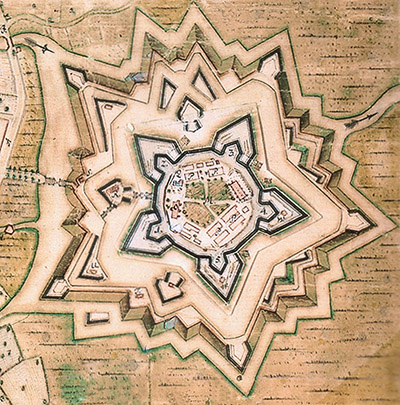 Zitadelle Vechta in 1770. Zitadelle Vechta in 1770. |
|
The Seven Years' War came about mostly because everyone in Europe wanted stuff that other people possessed. While in North America this conflict (which is remembered on this side of the Atlantic as the French and Indian War) resulted in much heroic starfortish endeavor accomplished by relatively small numbers of persons ( Fort William Henry, Fort Ticonderoga and Fort Frederick are three such heroically endeavorous forts), in Europe the Seven Years' War consisted of vast armies slugging it out in and around Central Europe.
|
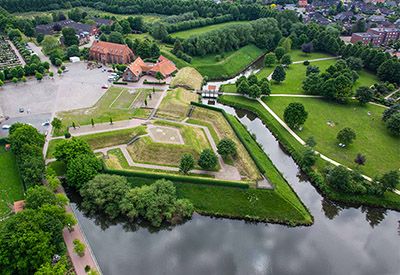
Zitadelle Vechta's Friedrich Christian Bastion, as it exists today. Thanks, reconstructors! |
 |
This slugging reached Vechta in 1758, in the form of a Prussian-Hanoverian army. Somehow it was universally established that the mighty Zitadelle, the pride of the Bishopric of Münster, a fort that had notionally been striking fear into the hearts of all the Bishopric's potential enemies for nearly a century, would be physically unable to defend itself against its technologically superior attacker. The fort was surrendered without a fight on April 1, 1758. Why was this? Often 17th-century starforts were undone by 18th-century artillery, but little in the way of specific explanation seems to exist on this matter. As far as I know, Zitadelle Vechta was surrendered because the Prussians and/or Hanoverians had better hats (  ) than the fort's defenders. |
|
|
The Zitadelle, exposed as a fraud, was mostly demolished in 1769. Left intact were its armory and Kaponier, which continued to serve as a prison through the Second World War (1939-1945). The fort's building materials, doors and other fittings were auctioned off, and used to build various edifices in the city Münster and elsewhere. The grounds on which the Zitadelle had existed were converted to "garden land."
|
Though ultimately undistinguished in battle, Zitadelle Vechta was nonetheless remembered fondly by the city's residents. Interest in the Zitadelle and the preceding Castrum Vechtense led to extensive archaeological excavations in the late 1980's, followed by the building of Citadel Park.
This park includes a reconstruction of Zitadelle Vechta's Friedrich Christian bastion, as well as a portion of the Castrum, which is populated with "living history" medieval re-enactors for the entertainment and education of visitors. |
 |
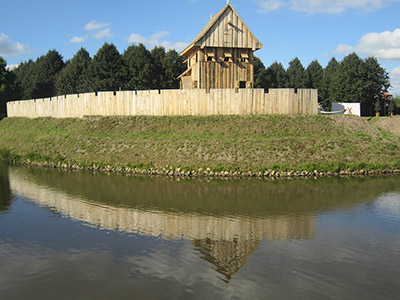 Castrum Vechtense's reconstructed Castle Tower, completed in 2013. |
|
|
|
|
|
|
|
 |




